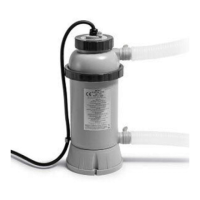(114UK) ELECTRIC POOL HEATER ENGLISH 4.875” X 7.25” PANTONE 295U 06/23/2022
114
UK
S AVE THESE INSTRUCTIONS
Page 11
COMMON POOL PROBLEMS
PROBLEM DESCRIPTION CAUSE REMEDY
ALGAE
• Greenish water.
• Green or black spots
on pool liner.
• Pool liner is slippery
and/or has a bad
odor.
• Chlorine and pH
levels need
adjustment.
• Super chlorinate with shock
treatment. Correct pH to
your pool store’s
recommended level.
• Vacuum pool bottom.
• Maintain proper chlorine level.
COLORED WATER
• Water turns blue,
brown, or black
when first treated
with chlorine.
• Copper, iron or
maganese in water
being oxidized by
the added chlorine.
• Adjust pH to recommended
level.
• Run filter until water is clear.
• Clean cartridge frequently.
SUSPENDED
MATTER IN
WATER
• Water is cloudy or
milky.
• “Hard water” caused
by pH level being too
high.
• Chlorine content is low.
• Foreign matter in water.
• Correct pH. Check with pool
dealer for water treatment.
• Check for proper chlorine
level.
• Clean or replace your filter.
CHRONIC LOW
WATER LEVEL
• Level is lower than
on previous day.
• Rip or hole in pool liner
or hoses.
• Repair with patch kit.
• Finger tighten all caps.
SEDIMENT ON
POOL BOTTOM
• Dirt or sand on pool
floor.
• Heavy use, getting in
and out of pool.
• Use Intex pool vacuum to
clean bottom of pool.
SURFACE DEBRIS
• Leaves, insects etc. • Pool too close to trees. • Use Intex pool skimmer.
GENERAL AQUATIC SAFETY
Water recreation is both fun and therapeutic. However, it involves inherent risks of
injury and death. To reduce your risk of injury, read and follow all product, package
and package insert warnings and instructions. Remember, however, that product
warnings, instructions and safety guidelines cover some common risks of water
recreation, but do not cover all risks and or dangers.
For additional safeguards, also familiarize yourself with the following geeral guidelines
as well as guidelines provided by nationally recognized Safety Organizations:
• Demand constant supervision. A competent adult should be appointed as a “lifeguard”
or water watcher, especially when children are in and around the pool.
• Learn to swim.
• Take the time to learn CPR and first aid.
• Instruct anyone who is supervising pool users about potential pool hazards and about
the use of protective devices such as locked doors, barriers, etc.
• Instruct all pool users, including children what to do in case of an emergency.
• Always use common sense and good judgement when enjoying any water activity.
• Supervise, supervise, supervise.

